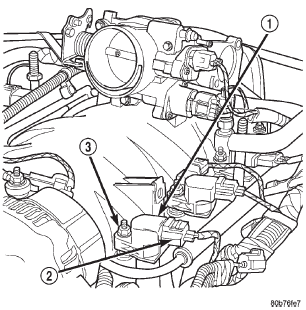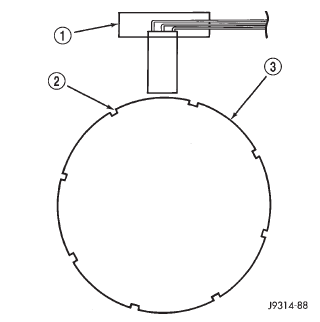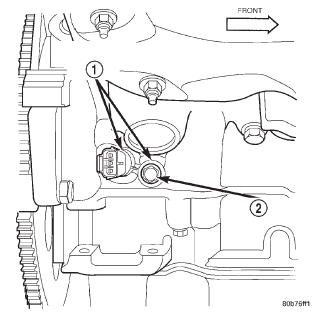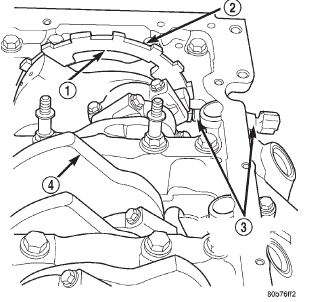Crankshaft position sensor-5.2/5.9L v-8 engine. Crankshaft position sensor-4.7L engine
DESCRIPTION The Crankshaft Position (CKP) sensor is located
near the outer edge of the flywheel (starter ringear).
1 - IGNITION COIL 2 - COIL ELECTRICAL CONNECTOR 3 - COIL MOUNTING STUD/NUT OPERATION Engine speed and crankshaft position are provided
through the CKP sensor. The sensor generates pulses
that are the input sent to the Powertrain Control
Module (PCM). The PCM interprets the sensor input
to determine the crankshaft position. The PCM then
uses this position, along with other inputs, to determine
injector sequence and ignition timing.
The sensor is a hall effect device combined with an
internal magnet. It is also sensitive to steel within a
certain distance from it.
On 5.2/5.9L V-8 engines, the flywheel/drive plate
has 8 single notches, spaced every 45 degrees, at its
outer edge (Fig. 4).
The notches cause a pulse to be generated when
they pass under the sensor. The pulses are the input
to the PCM. For each engine revolution, there are 8
pulses generated on V-8 engines.
The engine will not operate if the PCM does not
receive a CKP sensor input. DESCRIPTION The Crankshaft Position Sensor (CKP) is mounted
into the right-rear side of the engine block (Fig. 5).
1 - CRANKSHAFT POSITION SENSOR 2 - NOTCHES 3 - FLYWHEEL
1 - CRANKSHAFT POSITION SENSOR 2 - MOUNTING BOLT OPERATION Engine speed and crankshaft position are provided
through the crankshaft position sensor. The sensor
generates pulses that are the input sent to the powertrain
control module (PCM). The PCM interprets
the sensor input to determine the crankshaft position.
The PCM then uses this position, along with
other inputs, to determine injector sequence and ignition
timing.
The sensor is a hall effect device combined with an
internal magnet. It is also sensitive to steel within a
certain distance from it.
On the 4.7L V-8 engine, a tonewheel is bolted to
the engine crankshaft (Fig. 6). This tonewheel has
sets of notches at its outer edge (Fig. 6).
The notches cause a pulse to be generated when
they pass under the sensor. The pulses are the input
to the PCM.
1 - TONEWHEEL 2 - NOTCHES 3 - CRANKSHAFT POSITION SENSOR 4 - CRANKSHAFTCrankshaft position sensor-5.2/5.9L v-8 engine
 Fig. 3 Ignition Coil Location-4.7L Engine
Fig. 3 Ignition Coil Location-4.7L EngineCrankshaft position sensor-4.7L engine
 Fig. 4 CKP Sensor Operation-5.2L/5.9L Engine
Fig. 4 CKP Sensor Operation-5.2L/5.9L Engine Fig. 5 CKP Sensor Location-4.7L V-8 Engine
Fig. 5 CKP Sensor Location-4.7L V-8 Engine Fig. 6 CKP Sensor Operation and Tonewheel-4.7L V-8 Engine
Fig. 6 CKP Sensor Operation and Tonewheel-4.7L V-8 Engine
Dodge Durango (DN) 1998-2003 Service Manual
- Lubrication and Maintenance
- Suspension
- Differential and Driveline
- Brakes
- Cooling System
- Battery
- Starting Systems
- Charging System
- Ignition System
- Instrument Panel Systems
- Audio Systems
- Horn Systems
- Speed Control System
- Turn Signal and Hazard Warning Systems
- Wiper and Washer Systems
- Lamps
- Passive Restraint Systems
- Electrically Heated Systems
- Power Distribution System
- Power Lock Systems
- Vehicle Theft/Security Systems
- Power Seat System
- Power Window Systems
- Power Mirror Systems
- Chime/Buzzer Warning Systems
- Overhead Console Systems
- Engine
- Exhaust System
- Frame and Bumpers
- Fuel System
- Steering
- Transmission and Transfer Case
- Tires and Wheels
- Body
- Heating and Air Conditioning
- Emission Control Systems
- Introduction
